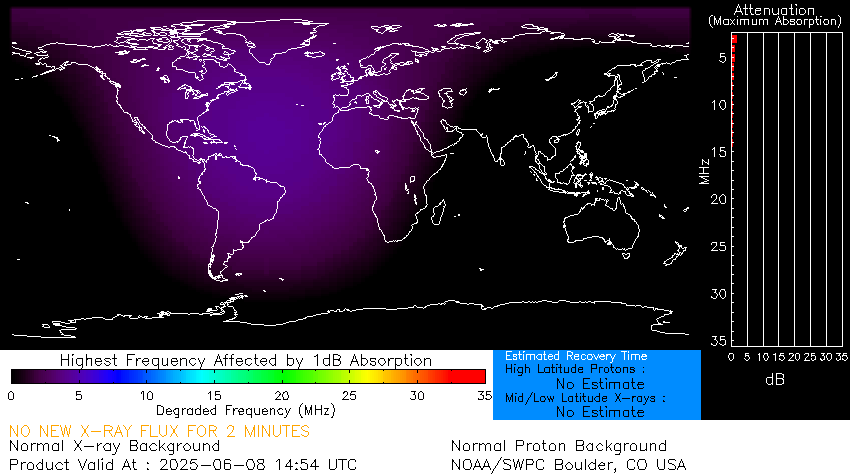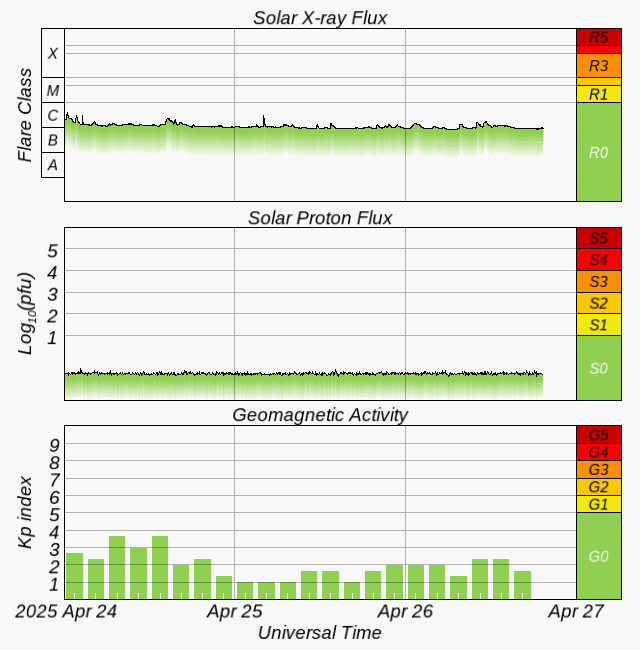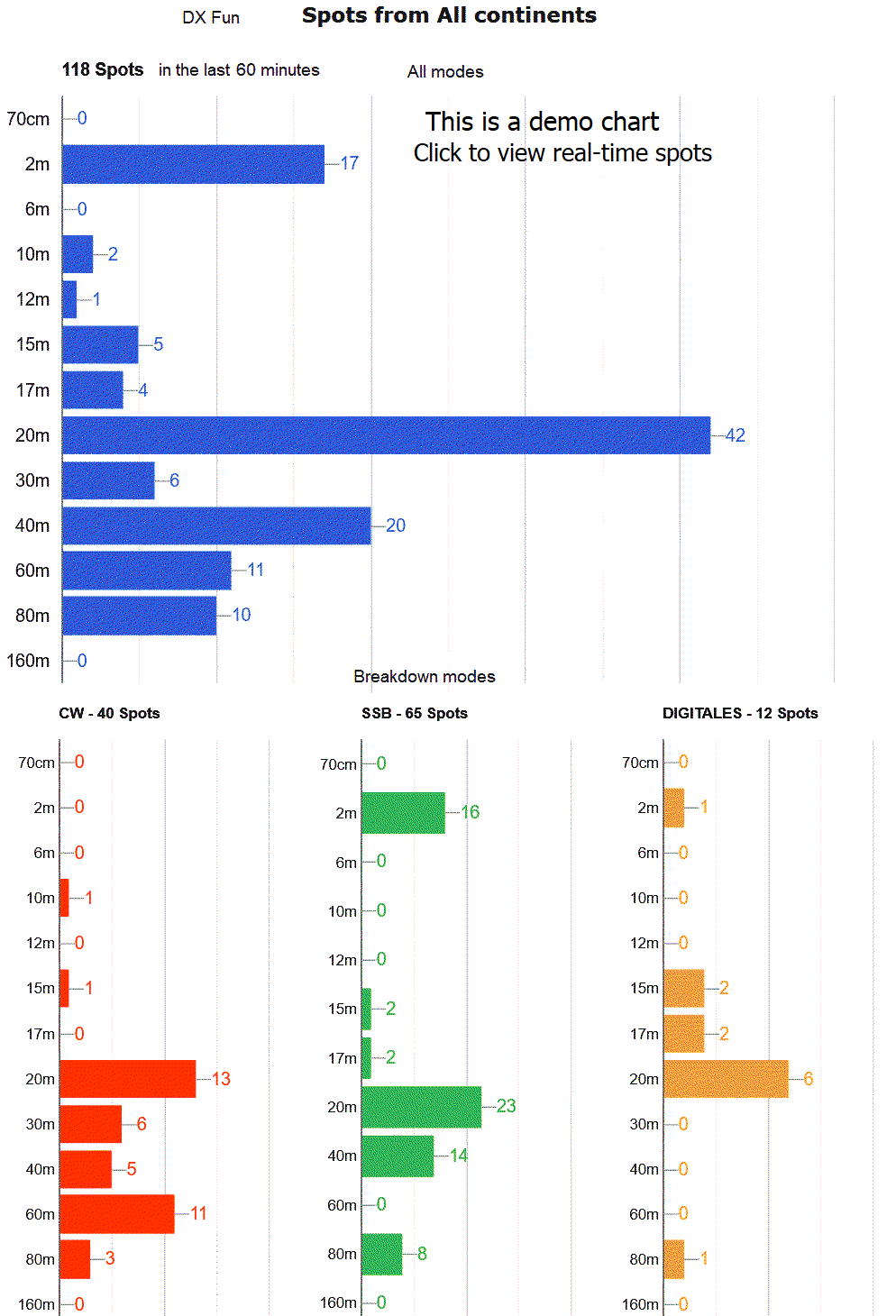
 Current Ham Band Conditions
Current Ham Band Conditions
Which Ham Bands are open now?
Explained maps, charts and tools
Find DX openings using propagation charts:
- Long-range ham radio communication relies on skywave propagation.
- Skywave band conditions shift constantly by the minute and across longer timeframes.

- Factors like time of day, solar activity, and ionospheric conditions drive these changes.
- Propagation charts visually aid in signal clarity estimation and long-distance communication potential by highlighting factors like MUF, solar flux, geography, and geomagnetic activity.
- The following propagation charts explain how and when certain communication paths might open or close.
|
Regional Propagation Maps
based on ham activity and ionosondes. Pros: Shows geographical distribution Cons: Implicit info about disruptions! Recent Ham Activity (last 15 minutes)
 real-time reports on 11 bands (160-6 m). Recent MUF Conditions (last 15 minutes)
Iso-frequency contours of 8 ham bands based on data from ionosondes. The predicted Regional LUF Conditions
 Global map of the recent LUF shows the predicted attenuation from 3 to 35 MHz due to solar and spaceweather events. Point-to-Point 24-hour forecast—HF planner
|
Global Conditions Charts
based on solar-terrestrial data. Pros: Comm. disruptions at a glance Cons: No geographical distribution! Recent R-S-G reports  Solar flares | More Space weather reports |
The charts explained below provide a visual representation of amateur radio band activity, helping operators with band usage.
Real-time radio propagation from active stations
- DXView: A real-time map of worldwide ham activity on HF bands designed by Jon Harder, NG0E.
This map hints at ham band conditions across the globe, refreshing every 15 minutes. It tracks real-time activity on 11 bands ranging from 1.8 to 54 MHz. Data comes from reliable sources, including DX Cluster, WSPRnet, RBN ↗, and PSK reporters (CW, FT4, FT8). Some of these reporters offer information on the signal-to-noise ratio (SNR) levels. The DXView website provides a guide on interpreting the map and selecting band colors.
Clarifications:
- This map uses data from clusters updated once every minute.
- MUF (Maximum Usable Frequency) is the highest frequency that allows for two-way communication. Given that the display is based on real-time data, MUF can be considered the highest frequency used on this map.
- The map indicates reported SNR levels (dB) with three different shades: SSB (SNR > 10), CW (SNR > -1), or digital modes (SNR > -28).
Spotting recent activity up to 60 minutes from all continents
See below a demo of "Spots from All Continents" showing ham-band activity across 13 bands, 160 meters to 70 centimeters.

Figure 2: A demo: Real-time Ham Band Active Spots
from all continents; all modes and breakdown of modes (CW, SSB, and digital)
Click on the above chart to view real-time.
- The MUF3000 map below shows ham band propagation conditions in the past 15 minutes,
This map offers a quick visual snapshot of current DX conditions on 8 ham bands (60, 40, 30, 20, 17, 15, 12, 10 m) marked by iso-frequency contours. The map shows MUF (Maximum Usable Frequency) levels across different regions, based on data from ionosondes. Each region’s MUF is represented by a numbered, colored disc, indicating the highest frequency suitable for long-distance (3,000 km) communication. Read more.
- Explore additional real-time maps and charts (NVIS, MUF, and LUF), each with a clear explanation.
- Monitoring Propagation: Stay updated on real-time changes in propagation conditions by regularly checking HF band activity. Consider integrating insights from multiple sources with the data presented in these maps for a more comprehensive understanding.
Real-time ionospheric probing
Forecasting Tools
Radio propagation forecasts help radio operators optimize communication by determining the best frequencies and times to make contact with specific destinations.
For example, Andrew D. Rodland, KC2G, offers a free application called "HF Propagation Planner." This is an HF propagation planning and forecasting tool, similar to Proppy's Radcom Predictions. While prediction tools rely on "global monthly average" ionospheric conditions, this planner makes a regional short-term forecast using real-time data. ↗
See an example with explanations.
Odd propagation conditions
Chaotic solar and geomagnetic activity cause "odd" propagation conditions that differ from the standard day/night cycle. These "bad" conditions can result in unexpected signal blackouts, as well as "good" conditions on the VHF band.
Conclusion:
HF band condition charts, applications, and tools help operators understand and optimize long-distance communication. The main page, "Understanding HF Propagation," provides real-time data, forecasts, and extended tutorials that make skywave propagation easier to understand.
